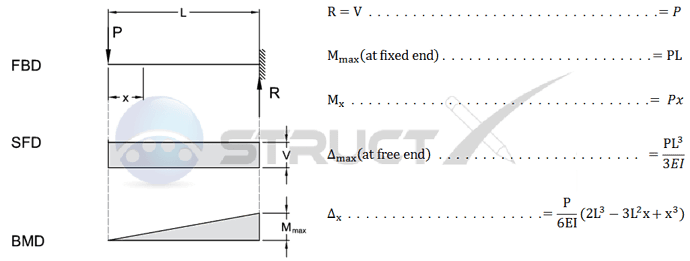Hint: At which location along the beam will the cantilever fail?
On a wall-mounted cantilever beam, the maximum bending moment, hence bending stress occurs at the fixed side of the beam where it’s mounted. This is visually illustrated in the bending moment diagram below. The point load causes the beam to bend, inducing tension and compression in the material.
For the cantilever beam, the top and bottom sides are subjected to two difference forces: compressive and tensile forces respectively.
- Top Side: Tension (-> away from wall)
- Bottom Side: Compression (<- toward wall)
If the cantilever beam material has a lower compressive yield strength than a tensile yield strength, the beam will fail at the bottom. Alternatively, if the tensile yield strength is lower, the beam will fail at the top.
A good example of materials that have varying compressive vs. tensile strength values are concrete and ceramics. These materials typically have much stronger compressive strength relative to tensile strength.
Check out this Youtube Video for a good visual reference.
Why the beam will fail at the top if the cantilever beam material has a lower compressive yield strength than a tensile yield strength?
In my mind, if the material has a lower compressive yield strength < tensile yield strength, the cantilever beam should fail at the compressive area, which is the bottom point (assume a point load’s direction is downward)
Hey @Weijun_Zhang, good catch! The original solution didn’t have that updated. Different materials have varying values for compressive and tensile yield strength, so your logic is correct.
I want to make sure I fully understand.
For this statement: “If the cantilever beam material has a lower compressive yield strength than a tensile yield strength, the beam will fail at the bottom. Alternatively, if the tensile yield strength is lower, the beam will fail at the bottom.”
So it’ll always fail at the bottom? Or is this a typo?
For example, for a steel cantilever beam with a free-end w/ point load, the maximum moment will be at the fixed end, and will cause it to fail at the fixed end. Does that mean, if steel’s tension strength is higher, it’ll fail on the compression side, so the bottom of the beam? Would that occur at the bottom of the beam at the fixed point?
@serket Good catch with the typo, the original solution is fixed. ![]()
The failure of a material under stress occurs on the side where its compressive or tensile strength is weaker.Here’s a general overview of tensile & compressive strength relationships for common types of materials:
- Metals Many metals and alloys tend to have balanced tensile and compressive strengths. This is because their crystalline structures generally respond similarly to tension and compression. However, some metals may be treated or alloyed to enhance one type of strength over the other.
- Composites: Composite materials, such as fiberglass or carbon fiber composites, often exhibit higher tensile strength than compressive strength. This is due to the way fibers within the composite material bear load when stretched, which is typically more efficient than when they are subjected to compression.
- Ceramics and Glasses: Ceramics and glasses usually have higher compressive strengths than tensile strengths. They are brittle and tend to crack under tension, but can support substantial loads in compression.
- Polymers/Plastics: The relationship between tensile and compressive strength in polymers and plastics can vary widely depending on the material type and its treatment. Some plastics may have higher tensile strength, while others may be stronger in compression.
- Concrete: Concrete is a common construction material with significantly higher compressive strength than tensile strength. This is why it is often reinforced with materials like steel that have high tensile strength.
